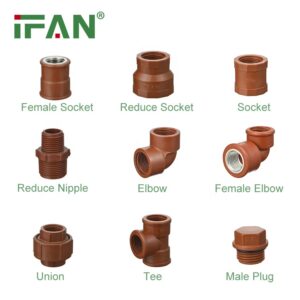Description
Introduction:
Polypropylene Homopolymer (PPH) and Polyvinyl Chloride (PVC) are two widely used materials in the construction of pipe fittings. This article presents a comprehensive comparison between PPH pipe fittings and PVC pipe fittings, focusing on their material characteristics, suitability in various environments, and cost considerations.

Material Characteristics: PPH Pipe Fittings And PVC Pipe Fittings
PPH Pipe Fittings:
PPH is a thermoplastic material known for its excellent chemical resistance, high impact strength, and low moisture absorption rate. PPH exhibits remarkable stability against acids, alkalis, and other corrosive substances. It maintains its mechanical properties even at elevated temperatures, making it suitable for hot fluid transport applications.
PVC Pipe Fittings:
PVC is a versatile thermoplastic material with good chemical resistance, particularly against acids and bases. PVC exhibits exceptional electrical insulation properties and is lightweight, making it easy to handle and install. However, it has lower impact strength compared to PPH and can become brittle at low temperatures.

Environmental Suitability: PPH Vs. PVC Pipe Fittings
PPH Pipe Fittings:
PPH excels in applications involving aggressive chemical environments and high temperatures. It is well-suited for industries such as chemical processing, water treatment, and pharmaceuticals, where resistance to chemical corrosion is crucial. Its ability to withstand a wide range of corrosive fluids contributes to its longevity.
PVC Pipe Fittings:
PVC is commonly used for drainage, wastewater systems, and low-pressure applications. It may not be suitable for conveying aggressive chemicals or high-temperature fluids. PVC is more prone to chemical attack in certain conditions, limiting its use in corrosive environments.

Cost Considerations: PPH Pipe Fittings Vs. PVC Pipe Fittings
PPH Pipe Fittings:
PPH is generally more expensive than PVC due to its superior chemical resistance and higher temperature stability. While the initial cost of PPH pipe fittings might be higher, the extended lifespan and reduced maintenance needs can contribute to long-term cost savings, especially in aggressive environments.
PVC Pipe Fittings:
PVC is often chosen for its lower upfront cost and ease of installation. In less demanding applications where chemical resistance and high temperatures are not critical, PVC can provide a cost-effective solution. However, the potential need for earlier replacements and maintenance should be considered for longer-term projects.
Conclusion: Selecting The Right Fit
The choice between PPH and PVC pipe fittings depends on the specific requirements of the project. PPH is a preferred choice for applications demanding exceptional chemical resistance and high-temperature capabilities. PVC is suitable for less aggressive environments and can offer cost advantages in certain scenarios. Engineers, designers, and project managers should carefully evaluate the material characteristics, environmental conditions, and budget considerations to make an informed decision that aligns with the project’s goals and long-term sustainability.
Related products
-
PPH Fitting
IFAN PPH Pipe Fitting
-
PPH
PPH Pipe










